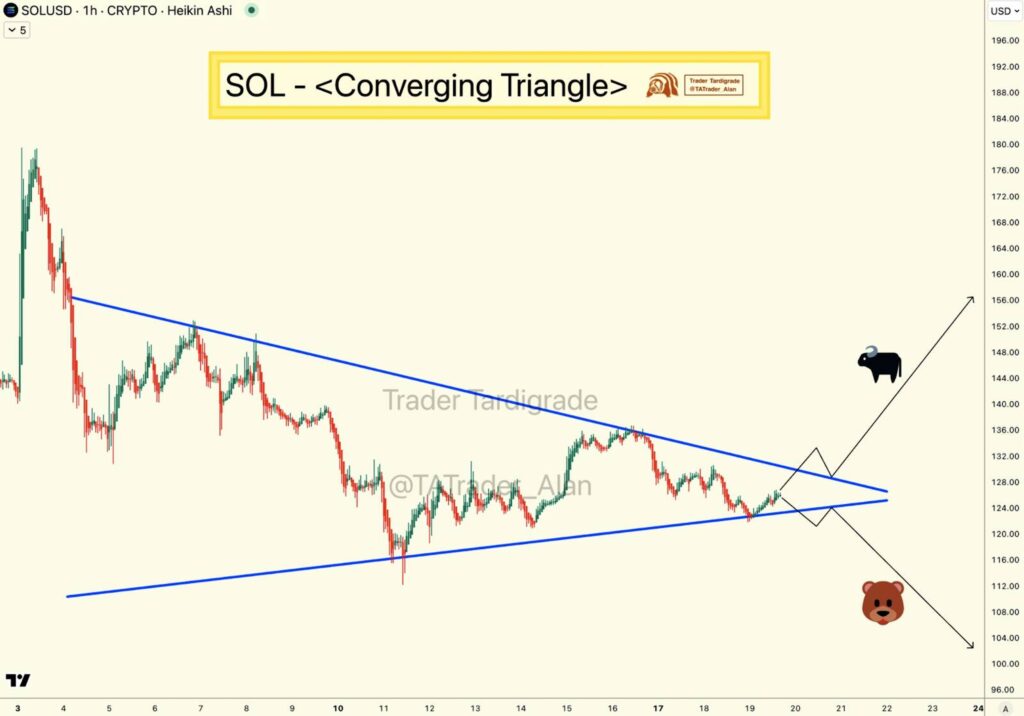The cryptocurrency landscape continues to shift dramatically, particularly for the Solana network, where recent developments are stirring considerable attention among investors. A spike in trading activity involving Tether’s USDt (USDT) stablecoin, along with emerging technical patterns, suggest a potential surge in volatility for Solana’s native token, SOL. This follows a notable 137% increase in USDT trading volume on Solana during the last week of February, contrasting sharply with a previous week that saw a 61% decline, as reported by Mercuryo, a global payments infrastructure platform. These fluctuations are prompting traders to readjust their positions, possibly in pursuit of new investment opportunities.
Petr Kozyakov, CEO of Mercuryo, emphasized the “frenetic activity” observed on Solana and noted, “the chain is prone to be more volatile.” He attributed this to various factors, including Solana’s fast transaction capabilities and a bustling trading ecosystem, which continues to attract high volumes of activity.
Furthermore, specific decentralized exchanges (DEXs) on the Solana network, such as Jupiter and Raydium, have ignited increased interest as traders explore options amidst the current shifts. Meanwhile, a key technical chart pattern, identified as a Converging Triangle, may play a crucial role in determining the future price action of SOL, according to crypto analyst Trader Tardigrade.
However, not everything is pointing towards growth for Solana. Factors such as the ongoing memecoin craze may be diverting liquidity away from SOL. Additionally, the implications of the FTX exchange’s repayment plan loom over the market, as significant amounts of SOL tokens are poised to enter circulation. Following a recent unlock activity that released over 1 million in SOL tokens, the potential for increased selling pressure could complicate price movements further.
As the cryptocurrency industry progresses through this complex phase, all eyes will be on Solana to see how these factors coalesce in the coming weeks, particularly as FTX approaches another repayment deadline on May 30. This event could be pivotal not just for the creditors involved but also for the broader market sentiment surrounding Solana and its future trajectory.
Investors’ Stablecoin Positioning on Solana Network
The recent trading activity surrounding stablecoins on the Solana network presents both opportunities and risks for investors. Here are the key points:
- Extreme Volatility:
- USDT trading on Solana’s transport layer surged over 137% in late February after experiencing a 61% decline the previous week.
- This behavior indicates that traders are actively seeking new investment opportunities, contributing to market volatility.
- Potential for Increased Volatility:
- According to Mercuryo’s CEO, the intense trading activity may suggest that the Solana ecosystem is becoming more volatile.
- Factors such as fast transaction processing and high scalability could influence both trading volumes and price stability.
- Technical Chart Pattern:
- A converging triangle pattern has emerged on Solana’s Heikin Ashi hourly chart, indicating potential for both bullish and bearish price movements.
- Investors should closely monitor this pattern for potential trading signals.
- External Factors Impacting SOL Price:
- The memecoin market frenzy is believed to siphon liquidity away from the Solana token, affecting its price.
- Repayments from the bankrupt FTX exchange could also impose selling pressure on SOL, with large amounts of tokens set for distribution to creditors.
- FTX Repayment Plan:
- FTX plans to sell digital assets under specific court-imposed limits, potentially affecting market liquidity and SOL price movements.
- The next repayment round is scheduled for May 30, impacting investor confidence and market dynamics.
“The frenetic activity may indicate that the chain is prone to be more volatile.” – Petr Kozyakov
These dynamics can influence investor strategies and approaches to trading on the Solana network, directly impacting their potential gains or losses in a market characterized by rapid shifts.
The Volatile Landscape of Solana: Analyzing Stablecoin Dynamics and Market Forces
As the Solana network surfaces in the news with its recent fluctuations in stablecoin trading, a comparative look at other similar ecosystems reveals both the competitive edge and potential drawbacks of this blockchain. The Solana environment is distinct in its rapid transaction speeds and exemplary scalability, qualities that are increasingly attractive to investors and traders alike. However, this appeal can also lead to significant volatility, as noted by the staggering 137% surge in Tether (USDT) trading on Solana. Such extreme variations signal a marketplace that might be ripe for speculative activity, echoing trends witnessed in other competitive networks like Ethereum and Binance Smart Chain.
In contrast to Solana’s volatility, networks like Ethereum are better known for their robust liquidity and slower, yet more stable, market movements. While high volatility may attract risk-tolerant traders looking for quick gains, the same volatility poses a danger for long-term investors worried about potential losses. As Solana continues to draw in traders seeking to capitalize on its fast-paced trading environment, it could potentially alienate those who favor steadier investment growth. This may not bode well for conservative investors who could find themselves navigating a sea of uncertainty.
Moreover, the “frenetic activity” in Solana trading, highlighted by experts like Mercuryo’s CEO Petr Kozyakov, reflects a competitive advantage in attracting market participants but presents risks such as increased susceptibility to market manipulation. When comparing Solana to competitors, it’s crucial to note that while DeFi projects like Aave on Ethereum possess extensive user bases and trust factors built over time, Solana’s new entrants like Jupiter and Raydium are still in the process of solidifying their reputations. The volatile trading conditions may deter apprehensive traders from participating, while offering opportunity for risk-seekers.
Additionally, the looming issue of liquidity extraction as a result of the FTX repayments may limit Solana’s upward price momentum moving forward. The potential selling pressure from creditors receiving SOL tokens could indeed complicate the token’s price trajectory. In this context, investors already exposed to SOL must weigh the potential implications of these external forces against the backdrop of their investment strategies. This scenario could bring challenges for retail investors but offer strategic openings for institutional players who may benefit from such extraordinary price swings.
Ultimately, as Solana navigates these market dynamics influenced by both stablecoin trading patterns and legacy issues like the FTX repayment plan, stakeholders must remain vigilant. The landscape is as promising as it is perilous, and understanding the nuances of such a rapidly evolving environment remains vital for making informed investment decisions.

















